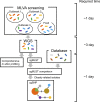Effective Surveillance Using Multilocus Variable-Number Tandem-Repeat Analysis and Whole-Genome Sequencing for Enterohemorrhagic Escherichia coli O157
- PMID: 31227555
- PMCID: PMC6696959
- DOI: 10.1128/AEM.00728-19
Effective Surveillance Using Multilocus Variable-Number Tandem-Repeat Analysis and Whole-Genome Sequencing for Enterohemorrhagic Escherichia coli O157
Abstract
Due to the potential of enterohemorrhagic Escherichia coli (EHEC) serogroup O157 to cause large food borne outbreaks, national and international surveillance is necessary. For developing an effective method of molecular surveillance, a conventional method, multilocus variable-number tandem-repeat analysis (MLVA), and whole-genome sequencing (WGS) analysis were compared. WGS of 369 isolates of EHEC O157 belonging to 7 major MLVA types and their relatives were subjected to comprehensive in silico typing, core genome single nucleotide polymorphism (cgSNP), and core genome multilocus sequence typing (cgMLST) analyses. The typing resolution was the highest in cgSNP analysis. However, determination of the sequence of the mismatch repair protein gene mutS is necessary because spontaneous deletion of the gene could lead to a hypermutator phenotype. MLVA had sufficient typing resolution for a short-term outbreak investigation and had advantages in rapidity and high throughput. cgMLST showed less typing resolution than cgSNP, but it is less time-consuming and does not require as much computer power. Therefore, cgMLST is suitable for comparisons using large data sets (e.g., international comparison using public databases). In conclusion, screening using MLVA followed by cgMLST and cgSNP analyses would provide the highest typing resolution and improve the accuracy and cost-effectiveness of EHEC O157 surveillance.IMPORTANCE Intensive surveillance for enterohemorrhagic Escherichia coli (EHEC) serogroup O157 is important to detect outbreaks and to prevent the spread of the bacterium. Recent advances in sequencing technology made molecular surveillance using whole-genome sequence (WGS) realistic. To develop rapid, high-throughput, and cost-effective typing methods for real-time surveillance, typing resolution of WGS and a conventional typing method, multilocus variable-number tandem-repeat analysis (MLVA), was evaluated. Nation-level systematic comparison of MLVA, core genome single nucleotide polymorphism (cgSNP), and core genome multilocus sequence typing (cgMLST) indicated that a combination of WGS and MLVA is a realistic approach to improve EHEC O157 surveillance.
Keywords: core genome SNP analysis; core genome multilocus sequence typing; enterohemorrhagic Escherichia coli; multilocus variable-number tandem-repeat analysis; whole-genome sequencing.
Copyright © 2019 American Society for Microbiology.
Figures








References
Publication types
MeSH terms
LinkOut - more resources
Full Text Sources
Medical

